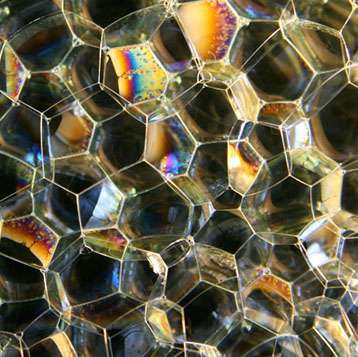How do liquid foams block sound?

Liquid foams have a remarkable property: they completely block the transmission of sound over a wide range of frequencies. CNRS physicists working in collaboration with teams from Paris Diderot and Rennes Universities have studied how sound is attenuated in liquid foams. Their findings, published in Physical Review Letters, open the way to the development of tools called acoustic probes that could be used to monitor the quality of foams used in industry, especially in the mining and petroleum sectors.
Much research has been carried out in acoustics in order to understand how sound propagates through a material. One of the classic approaches is to send an acoustic wave through it and listen to the response, which provides key information about the material, in the same way as listening to the sound produced by tapping on a wall indicates whether it is hollow. This is why researchers analyze how various materials, from the simplest to the most complex, react when they are struck.
One of these is however keeping its secrets: liquid foam. This is a difficult material to study since it is short-lived and sound does not travel through it easily. Until now, there has been no acoustic probe for foams. The most frequently used probes rely on electrical conductivity to determine the amount of liquid contained in a foam. However, some of these substances are made up of non-conducting liquid, making it impossible to characterize them. Adding liquid foams to the list of materials that can be probed by acoustic waves is therefore central to ensuring that every type of foam used can be fully characterized.
How do liquid foams block sound? A key finding has been revealed in a recent study by researchers from the 'Matière et Systèmes Complexes' Laboratory (CNRS/Université Paris Diderot) and the Institut de Physique de Rennes (CNRS/Université Rennes 1). The study, which is part of a project funded by the French National Research Agency (ANR), brings together for the first time acoustics experts and foam specialists. Characterization of foams is essential for measuring the speed and attenuation of sound in foams of known composition. The results show that sound propagation varies greatly according to the frequency of the wave used. The researchers propose a simple interpretation of these observations. Foams are made up of 90% air plus a liquid, and this liquid is distributed between films and channels that support them (see image below). However, these two structures have very different geometries and masses: films have a large surface area and a small mass, while channels are narrower but have greater mass. The vibration of air caused by the acoustic wave displaces the films, which in turn pull on the channels. At low frequencies, the speed of sound is very low (around 30 meters per second): the sound is slowed down by the coordinated motion of the films and channels, but is not blocked. At high frequencies, the speed of sound increases (approximately 220 meters per second): only the films move, thus also allowing the sound to travel through the foam. However, at intermediate frequencies, the films behave anomalously: they move in the "wrong" direction, in other words towards the left when the air displaced by the sound pushes them to the right, which prevents the channels from moving. The sound is therefore blocked in the bubbles over a wide range of frequencies.
This work thus helps to solve the mystery of acoustics in liquid foams. It will pave the way for the development of acoustic probes that can be applied to such materials, which are an everyday part of life as well as being widely used in industry.
More information: "Resonant Acoustic Propagation and Negative Density in Liquid Foams." J. Pierre, B. Dollet, and V. Leroy. Physical Review Letters. 11 April 2014, DOI : dx.doi.org/10.1103/PhysRevLett.112.148307
Journal information: Physical Review Letters
Provided by CNRS



















